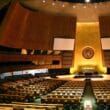Avoiding renewed arms races
By Tatiana Anichkina, September 25, 2014
Should arms control arrangements include limits on missile defense? They used to—under the 1972 Anti-Ballistic Missile Treaty. The treaty included limits only on strategic ballistic missile defense, not on regional or theater ballistic missile defense, but nonetheless it contributed to strategic stability. When the United States withdrew from the treaty in 2002, and began in 2004 to deploy missile defense capabilities that would not have been permitted before withdrawal, chances increased that a new nuclear arms race would emerge.
Since the termination of the treaty, Russia has embarked on a deep modernization of its own A-135 system for ballistic missile defense, presumably with a view to giving it a more layered structure. But Russia’s system is operational only around Moscow, and though it is capable of intercepting single or perhaps multiple ballistic missiles, it would be rather ineffective against a massive missile attack. Russia, unlike the United States, has no plans to extend its ballistic missile defense system worldwide.
The United States has already begun to deploy basic elements of what might become a global missile defense system. These include a variety of means for intercepting intercontinental ballistic missiles, submarine-launched ballistic missiles, and long-range air-launched cruise missiles—as well as medium- and short-range ballistic missiles. The US system’s capabilities are still limited. But if the number of interceptors were increased, and their performance were enhanced, significant challenges would be posed for international stability and security.
Regional powers, notably Russia and China, are deeply concerned by US plans to deploy elements of missile defense systems in locations around the world. For instance, George W. Bush’s plans to create a "third site" in Poland and the Czech Republic threatened to create a crisis in US-Russia relations. The crisis was averted only when the Obama administration abandoned Bush’s plans in 2009, opting instead to pursue a "phased adaptive approach"—basically, countering known missile threats through existing means while also pursuing new technologies to counter threats that might develop in the future. Still, Moscow believes that Europe-based elements of the US missile defense system are directed against Russia, even if Washington denies it. Russia’s concerns have not been alleviated by recent reports that some NATO countries are calling for the European missile defense system to be formally directed against Moscow.
It appears that the United States may also establish a regional missile defense system in Asia—an Asia-Pacific Phased Adaptive Approach—which would entail cooperation from Japan, South Korea, and other countries in the region. It would be a layered system whose first tier would include offshore combat ships armed to intercept ballistic missiles at the boost stage, or early in the midcourse of their flight trajectories. Ground-based systems would provide a second tier. Officially, such a system would protect US and allied troops and military facilities in the Asia-Pacific region from ballistic missiles launched by states such as North Korea. But China views such plans with concern, and it would be no surprise if Beijing took countermeasures against the deployment of such a system. The region’s strategic balance would be upset under such a scenario, efforts to achieve arms reductions would be hindered, and an arms race would become more likely.
But the greatest threat associated with US ballistic missile defense would be posed by the deployment of space-based capabilities. If Washington makes a political decision to deploy space-based weapons to intercept ballistic missiles, the militarization of outer space would become inevitable. The international community would be forced to stop complying with the Outer Space Treaty. The resulting arms race in space would have unpredictable consequences and would undermine the foundations of strategic stability.
Few alternatives. Given all this, it is essential that limits be placed on ballistic missile defense within the framework of the international arms control regime. What alternatives to such an approach exist? Only two. First, missile defense could be transformed into a cooperative undertaking—something that Russia has proposed to the United States repeatedly, but to no avail. Second, nuclear powers could engage in a renewed arms race. Russian experts are already arguing that, in response to the US deployment of a global missile defense system, Moscow should withdraw from the Intermediate-Range Nuclear Forces Treaty and resume production of intermediate and short-range ballistic and cruise missiles. (The US government, meanwhile, argues that Russia has already violated that treaty.)
Preventing the proliferation of nuclear weapons is among the top priorities on the international security agenda. It is high on the agendas of many individual countries as well. But enforcing the international nonproliferation regime will be difficult if the unrestricted development of missile defense systems leads nuclear weapon states to engage in a renewed arms race of their own. A first practical step toward averting this outcome would be to address missile defense in the next stage of US-Russia arms control negotiations.
Topics: Nuclear Weapons
Share: [addthis tool="addthis_inline_share_toolbox"]














